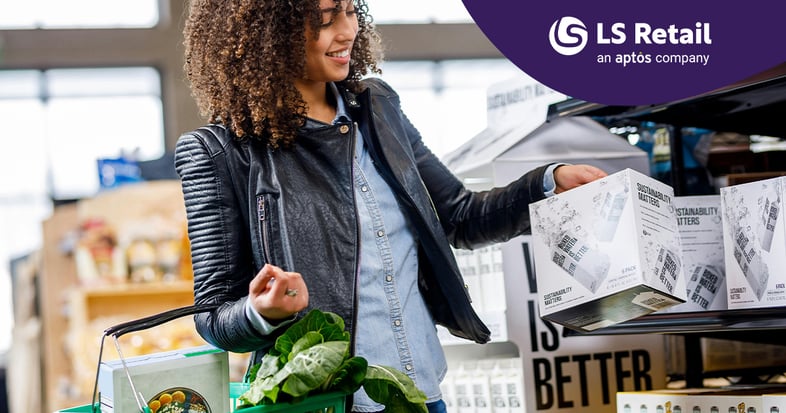5 ways to appeal to the modern consumer and boost sales in your store

We hear a great deal about how modern consumers, and the whole retail landscape, are changing. Expert predictions about the newest trends are a dime a dozen. As a retailer, it can sometimes feel like you’re navigating a minefield. There are so many things you could do to attract, retain, and impress customers, but will they all pay off?
Beyond the headlines, what is clear is that retail continues to transform and reinvent itself, like it has always done. And consumers want retailers to keep up with their latest expectations. At the same time, they also want many of the same old things.
To capture consumers’ attention, retailers must demonstrate they understand their customers and remain diligent about perfecting the experiences they deliver to encourage loyalty and increase sales.
Here are five ways you can stay in tune with customer needs and turn a profit:
1. Value sustainability
The modern consumer cares about the social and environmental impact of their purchasing and consumption. According to Deloitte’s Global State of the Consumer Tracker, 46% of consumers across 23 countries said they purchased at least one sustainable good or service in the beginning of 2023. And another study from The Business of Sustainability found that 78% of consumers want to buy from environmentally friendly companies, but don’t know how to identify them. Many consumers want to shop from brands that align with their ideals, and retailers need to be transparent about their environmental efforts and practices in order to earn trust and win loyalty. Here are some ways you can satisfy consumers looking for eco-friendly options:
- Make your commitment clear. Consumers want to know where your brand stands when it comes to environmental issues, and how you’re doing your part. If you don’t clearly communicate your strategy to your customers, chances are they’ll lose faith in your business. The Business of Sustainability Index report from GreenPrint found that only 38% of consumers actually believe corporations when they make claims about environmental sustainability.
- Invest in eco-friendly packaging. According to the 2023 PwC Global Consumer Insights survey, 78% of consumers said they would pay more for products that are produced locally or made from recycled, sustainable, or eco-friendly material. With many alternatives to single-use plastic packaging, you can investigate recycled cardboard and paper options, or even organic material packaging using cornstarch, mushrooms, and seaweed. Even better if you could source these materials locally and reduce shipping emissions.
- Recycle or buy-back products. Make it easier for customers to get rid of used products instead of sending them straight to the landfill. This can be a great way for retailers to recycle their own products and save on material costs, or re-sell them at a marked down price, while also using the opportunity to see how products wear and find ways to improve them for the future.
2. Offer memorable, engaging experiences
Today’s customers expect brands to deliver unique, immersive experiences that take traditional shopping methods to the next level. And while customers will still visit physical stores to view and try out products in person, they also appreciate the retailer’s ability to make the shopping experience more exciting. Retailers like Japanese fashion brand, UNIQLO, have included innovative pop-ups in select stores, like UMood which includes neuroscience technology that can read that brainwaves of the participant through a wearable device and suggest clothes according to their mood. Others, like Kroger, are making smart technologies more of a permanent addition to their strategy, such as using digital smart screens to showcase product information and advertisements, and helping customers make purchasing decisions based on their preferences, diets, budgets, and lifestyles. But if you don’t have the budget for this kind of technology, don’t worry, you can still create engaging experiences for customers in other ways:
- Experiment with pop-ups. Retailers can take the opportunity to sell limited edition items, showcase brand-new products, try out different concepts while also giving customers an interactive way to engage with the brand, or reach customers in locations where they may not have a physical store.
- Get involved in the community. Do things that will get customers excited about visiting your physical stores. Create special events, arrange in-store classes, or collaborate with local artisans to give them an experience they can’t get anywhere else
- Be social-media friendly. Offer interesting, “instagrammable” backdrops, installments, or showrooms that will entice customers to tag you on social media and generate more foot traffic in your stores, while also giving them an experience that fully encapsulates your brand.
3. Personalize in-store shopping
 Your customers expect you to be able to know and deliver what they want. According to a personalization survey from IT company CI&T, 52% of customers said they prefer retailers to create personalized shopping experiences for similar groups of customers, while 48% said they prefer when retailers offer personalized experiences tailored to individual customers. Having access to valuable customer data is crucial to being able to understand what types of customers shop with you, what they frequently buy, and how to cater to their expectations. When you have a system that can give you a real-time overview of your data and sales history, you can tailor the shopping experience based on your customers’ needs and encourage them to buy from you again. While personalization will look different for every retailer, here are a few tips to consider:
Your customers expect you to be able to know and deliver what they want. According to a personalization survey from IT company CI&T, 52% of customers said they prefer retailers to create personalized shopping experiences for similar groups of customers, while 48% said they prefer when retailers offer personalized experiences tailored to individual customers. Having access to valuable customer data is crucial to being able to understand what types of customers shop with you, what they frequently buy, and how to cater to their expectations. When you have a system that can give you a real-time overview of your data and sales history, you can tailor the shopping experience based on your customers’ needs and encourage them to buy from you again. While personalization will look different for every retailer, here are a few tips to consider:
- Offer a loyalty program. Give customers tangible, valuable rewards that will entice them to shop with you again. With the right system, you can even track customers based on their profile, see what rewards they redeem, and what they buy. This will enable you to create exclusive promotions and offers that align with their preferences and encourage them to buy again.
- Know your customers. What do your customers most often buy from you? When? What age groups, geographical locations, or gender identities does your target audience consist of? The better you know who your customers are, or what customers you want to reach out to, the more you can tailor the shopping experience to their needs.
- Don’t underestimate the power of AI. With powerful business intelligence tools, retailers can gain in-depth insights into trends or patterns in their customers’ behavior based on historical data, which will help them understand what their customers want and how they can deliver on expectations.
4. Let customers choose how they shop
 Global e-Commerce sales are expected to account for 21.2% of all retail sales by 2024. Because of the continuous interest in online shopping, retailers need to prioritize offering an omnichannel experience, so customers can shop seamlessly both online and in-store. Retailers who can’t deliver on omnichannel risk losing loyal customers as a result, with one report from Bazaarvoice finding that consumers who shop with omnichannel retailers tend to return and purchase more regularly. While you don’t need to be everywhere all the time in order to be a great omnichannel retailer, you do need to find ways to connect the shopping experience so that it bridges the gap between your online and offline shopping experiences and delivers consistency across channels. Here are some omnichannel tips to get you started:
Global e-Commerce sales are expected to account for 21.2% of all retail sales by 2024. Because of the continuous interest in online shopping, retailers need to prioritize offering an omnichannel experience, so customers can shop seamlessly both online and in-store. Retailers who can’t deliver on omnichannel risk losing loyal customers as a result, with one report from Bazaarvoice finding that consumers who shop with omnichannel retailers tend to return and purchase more regularly. While you don’t need to be everywhere all the time in order to be a great omnichannel retailer, you do need to find ways to connect the shopping experience so that it bridges the gap between your online and offline shopping experiences and delivers consistency across channels. Here are some omnichannel tips to get you started:
- Offer flexible delivery options. With expensive shipping costs often deterring customers from making an order, retailers can provide more affordable and convenient options that also drive traffic to their physical stores. Buy Online, Pickup In Store gives customers the choice to pick up their order from their preferred location. According to a recent Morning Consult report, 47% of shoppers who use BOPIS also buy more items when fetching their orders from the store.
- Make stock visible online. It can be frustrating for customers to walk into your store with the intent to buy a specific item, only to realize it’s not in stock. To keep your customers informed about what you have available, make sure you have a system that enables you to accurately portray stock availability online for each of your locations.
- Simplify the returns process. Making sure customers can take items they bought online and return them at any of your physical stores is essential for getting them to buy again. A recent survey from Invesp found that 92% of customers would return to a business with an easy returns process.
5. Make shopping fast and efficient
 Nothing frustrates customers today than a slow checkout experience. The 2023 State of Waiting in Line survey from Waitwhile reports that 57% of customers feel that waiting in a physical line is a waste of time, while 44% become more dissatisfied with businesses that have lines. To keep up with demands for faster service, retailers should look to technology to improve efficiency and meet customer expectations. Thankfully, there are a multitude of options retailers can choose from – and it won’t only benefit customers, but the business as well. With technology on your side, you can free up employees from the register to focus more on customer service, while giving customers more ways to checkout at their preferred speed. Here’s how retailers can use technology to satisfy customers:
Nothing frustrates customers today than a slow checkout experience. The 2023 State of Waiting in Line survey from Waitwhile reports that 57% of customers feel that waiting in a physical line is a waste of time, while 44% become more dissatisfied with businesses that have lines. To keep up with demands for faster service, retailers should look to technology to improve efficiency and meet customer expectations. Thankfully, there are a multitude of options retailers can choose from – and it won’t only benefit customers, but the business as well. With technology on your side, you can free up employees from the register to focus more on customer service, while giving customers more ways to checkout at their preferred speed. Here’s how retailers can use technology to satisfy customers:
- Utilize self-checkout kiosks. According to one Forbes article, 85% of customers report that using self-checkout is faster, and 66.3% said that speed is the reason they use it. Depending on your business, you may decide you want a mix of traditional and self-checkout lanes to reduce wait times and give customers the option to checkout their preferred way.
- Try mobile self-scanning. The number of self-scanning stores is expected to triple globally by 2027, according to a recent article from Retail Dive. Mobile self-scanning solutions eliminate lines altogether by allowing customers to scan items on their mobile phone and pay directly through a store’s app, giving them a faster shopping experience at their convenience.
- Consider a unified retail platform. Many retailers still use a combination of separate, disconnected systems that can’t communicate, leading to siloed information that slows down business and negatively affects customer experience. But a unified retail management system that combines sales, financials, sales, e-commerce, inventory management, loyalty, and much more, will allow you to manage your entire business on one platform and get the visibility you need to make shopping seamless.
Curious to know more about how a unified retail management system can help you meet customer demands? Contact us.

